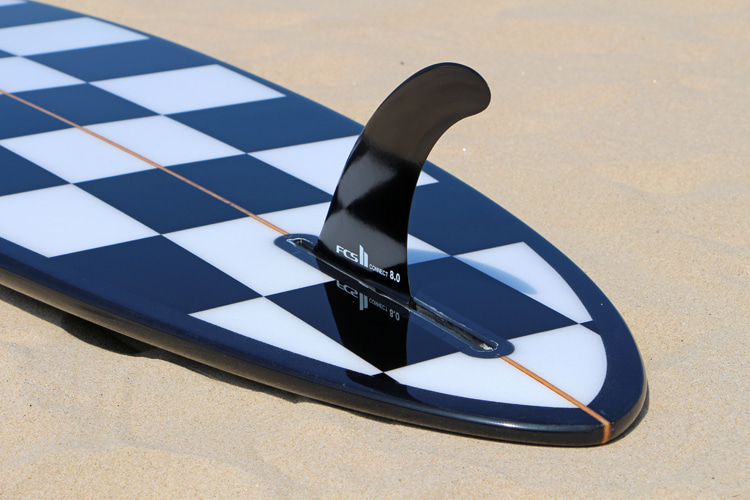
The single-fin is the first evolutionary stage of the modern surfboard fin setup. It also revolutionized the way people rode waves.
It’s quite surreal, but the early surfboards were finless for quite a while.
In the beginning, controlling a long and heavy wooden board was extremely difficult, as it would slide sideways easily.
Polynesians would use their feet to act as a skeg to force a turn or control a loose board.
When the Hawaiian island became one of the go-to tropical destinations for mainland Americans in the 1920s, surfing experiences at Honolulu’s Waikiki were one of the most popular holiday activities.
The local beach boys would take tourists to the water on their long and wide boards and catch a few gentle rollers toward the shore, tandem style.
Haoles were ecstatic with surfboarding.
Writers, actors, actresses, and royalty from all corners of the world would take on surfing like, fall for it, and return months and years later for more.
Soon, it made sense to improve the wave-riding equipment.

A Speedboat Metal Keel Changed Everything
But it wasn’t until 1935 that Tom Blake (1902-1994) attached a low-profile metal speedboat keel to the back of one of his paddleboards.
It was 12 inches (30 centimeters) long and four inches (10 centimeters) deep.
Despite its massive effect on the riding experience, Hawaiians did not immediately adopt the latest add-on.
“Blake’s invention didn’t catch on until after World War II; from the mid-1940s to the early 1970s, with a few rare exceptions, all boards had one fin,” notes Matt Warshaw, author of “The Encyclopedia of Surfing.”
Southern California surfers made the first experimentations by gluing crescent-shaped wooden fins onto the tails of their balsa boards.
Only then did it become a standard.
By the mid-1950s, surfboards commonly featured a fixed, slightly angled glass-on fin, usually around nine inches tall and nine inches long at the base.
In the mid-1960s, all-fiberglass fins – and soon after, molded plastic versions – started replacing older wood-and-fiberglass fins.
Around this time, fin designs also evolved to resemble a dolphin’s dorsal fin, which improved maneuverability and made turning smoother.
Most surfers didn’t think much about fin design until 1966 when Australian surfer Nat Young won the ISF World Surfing Championships using a unique, narrow-based “high-aspect ratio” fin.
This fin, designed by California kneeboarder George Greenough, significantly boosted Young’s ability to turn sharply and powerfully.
Young later credited his championship win to Greenough’s innovative fin design.

The Transition to the Twin Fin
According to the surf historian, “the expression ‘single-fin,’ however, didn’t become part of the surfing lexicon until the early 1970s, with the introduction of the short-lived first-generation twin-fin board.”
“When four-time world champion Mark Richards of Australia brought out his version of the twin-fin in 1977, there was a split between single-fin and twin-fin advocates as to which was the better small-wave performance board.”
“The singles were more stable and predictable; the twin-fin allowed for a wider tail, which increased the planing area and made for a faster and more maneuverable board in small waves.”
“When the surf hit about six feet, however, the added planing surface began to work against the twin-fin, making the board skittish and difficult to control; single-fins were the rule in bigger surf.”
And then Simon Anderson’s tri-fin “thruster” setup changed the paradigm once again, blending the advantages of its previous systems into what would become the world’s most popular surfboard fin combo.
The single-fin would not die.
In the late 1970s, an alternative movement anchored in the resurgence of the longboard surfboard started gaining momentum, and the original fin setup reconquered its space in the sport.

The Anatomy of the Single-Fin
Have you ever tried riding a longboard with and without a fin? The difference is huge.
Despite its simplicity, the single-fin is incredibly effective when mounted on the tail of a surfboard.
The universe of words to describe its contribution and impact on surfing is immense: control, stability, drive, balance, weight distribution, and lateral lift are only some of the advantages of having a skeg centered on the back of the surfboard’s bottom.
When Tom Blake bolted a speedboat’s metal part to his surfboard, the results were instant.
“My first wave revealed the truth. Never before had I experienced such control and stability,” Blake later revealed.
The single-fin setup is the freest of all the surfboard fin systems.
It allows surfers to draw carves, cutbacks, and smooth turns down the line on the wave’s unbroken face.
Because their overall surface is usually larger than any other fin setups, they allow the lower end of the board to pivot and hold when needed.
Nevertheless, the level of drag remains low compared to other skeg combinations.
Once you’re trimming the wave, the sole fin and board will increasingly generate speed without the need for pumping.
Single-fin surfboards can also excel inside the barrel, thanks to the skeg’s longer and deeper template.
When paddling into waves, it’ll also feel easier and faster, especially when compared to a thruster system.
In most cases, the more forward the single fin is moved away from the tail, the looser the board will feel.
Longboard noseriders often use a fin size (in inches) that matches their log’s size (in feet). For example, a nine-inch single fin for a nine-foot board.
The single-fin setup is no longer seen as a retro concept for old-school hipsters riding knee-high point break waves.
It’s become a valid, modern, and widely adopted option for nearly any surfboard shape, ocean conditions, and riding style.
Words by Luís MP | Founder of SurferToday.com


Leave a Reply